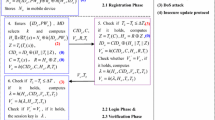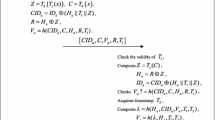Abstract
Dynamic ID authentication protects user’s identity from being revealed by any outsider during remote login processes. In independent multi-server environments, a user might have to login different servers for accessing various resources. Password based mechanisms are commonly utilized approaches. Without using complicated modular exponentiation computation, in this paper, the author will propose a Chebyshev chaotic map based dynamic ID authentication scheme for independent multi-server environments in which no trusted relationship exists among servers. The proposed scheme does not rely on the existence of registration center and each user only has to keep one single password for accessing resources of different servers. Compared with related protocols, the proposed one has more superior functionalities and lower computational costs. Furthermore, the session key security of our scheme is formally proved in the random oracle model.


Similar content being viewed by others
References
Awasthi, A. K. (2004). Comment on a dynamic ID-based remote user authentication scheme. Transaction on Cryptology, 1(2), 15–16.
Baptista, M. S. (1998). Cryptography with chaos. Physics Letters A, 240(1–2), 50–54.
Chang, C. C. & Kuo, J. Y. (2005). An efficient multi-server password authenticated key agreement scheme using smart cards with access control. In IEEE international conference on advanced information networking and applications (AINA 2005), Vol. 2, No. 56, pp. 257–260.
Chen, C., He, D., Chan, S., Bu, J., Gao, Y., & Fan, R. (2011). Lightweight and provably secure user authentication with anonymity for the global mobility network. International Journal of Communication Systems, 24(3), 347–362.
Das, M. L., Saxana, A., & Gulati, V. P. (2004). A dynamic ID-based remote user authentication scheme. IEEE Transactions on Consumer Electronics, 50(2), 629–631.
Diffie, W., & Hellman, M. (1976). New directions in cryptography. IEEE Transactions on Information Theory, IT-22(6), 644–654.
Gong, P., Li, P., & Shi, W. B. (2012). A secure chaotic maps-based key agreement protocol without using smart cards. Nonlinear Dynamics, 70(4), 2401–2406.
He, D., Chen, Y., & Chen, J. H. (2012). Cryptanalysis and improvement of an extended chaotic maps-based key agreement protocol. Nonlinear Dynamics, 69(3), 1149–1157.
He, D., Chen, J., & Zhang, R. (2011). A more secure authentication scheme for telecare medicine information systems. Journal of Medical Systems, 36(3), 1989–1995.
He, D., Zeadally, S., Kumar, N., & Wu, W. (2016). Efficient and anonymous mobile user authentication protocol using self-certified public key cryptography for multi-server architectures. IEEE Transactions on Information Forensics and Security, 11(9), 2052–2064.
Han, S. (2008). Security of a key agreement protocol based on chaotic maps. Chaos, Solitons & Fractals, 38(3), 764–768.
Hwang, M. S., & Li, L. H. (2000). A new remote user authentication scheme using smart cards. IEEE Transactions on Consumer Electronics, 46(1), 28–30.
Hwang, R. J., & Shiau, S. H. (2007). Provably efficient authenticated key agreement protocol for multi-servers. The Computer Journal, 50(5), 602–615.
Jiang, Q., Khan, M. K., Lu, X., Ma, J., & He, D. (2016). A privacy preserving three-factor authentication protocol for e-health clouds. Journal of Supercomputing. doi:10.1007/s11227-015-1610-x.
Jiang, Q., Ma, J., Li, G., & Li, X. (2015). Improvement of robust smart-card-based password authentication scheme. International Journal of Communication Systems, 28(2), 383–393.
Jiang, Q., Wei, F., Fu, S., Ma, J., Li, G., & Alelaiwi, A. (2016). Robust extended chaotic maps-based three-factor authentication scheme preserving biometric template privacy. Nonlinear Dynamics, 83(4), 2085–2101.
Juang, W. S. (2004). Efficient multi-server password authentication key agreement using smart cards. IEEE Transaction on Consumer Electronics, 50(1), 251–255.
Juang, W. S., & Wu, J. L. (2009). Two efficient two-factor authenticated key exchange protocols in public wireless lans. Computers & Electrical Engineering, 1(35), 33–40.
Khan, M. K., Kim, S. K., & Alghathbar, K. (2011). Cryptanalysis and security enhancement of a more efficient and secure dynamic ID-based remote user authentication scheme. Computer Communications, 34(3), 305–309.
Kocarev, L. (2001). Chaos-based cryptography: A brief overview. IEEE Circuits and Systems Magazine, 1(3), 6–21.
Ku, W. C., & Chang, S. T. (2005). Impersonation attacks on a dynamic ID-based remote user authentication scheme using smart cards. IEICE Transactions on Communications, E88-B(5), 2165–2167.
Lamport, L. (1981). Password authentication with insecure communication. Communications of the ACM, 24(11), 770–772.
Lee, C. C., Chen, C. L., Wu, C. Y., & Huang, S. Y. (2012). An extended chaotic maps-based key agreement protocol with user anonymity. Nonlinear Dynamics, 69(1–2), 79–87.
Lee, C. C., & Hsu, C. W. (2012). A secure biometric-based remote user authentication with key agreement scheme using extended chaotic maps. Nonlinear Dynamics, 71(1–2), 201–211.
Lee, C. C., Li, C. T., & Hsu, C. W. (2013). A three-party password-based authenticated key exchange protocol with user anonymity using extended chaotic maps. Nonlinear Dynamics,. doi:10.1007/s11071-013-0772-4.
Liao, I., Lee, C. C., & Hwang, M. S. (2005). Security enhancement for a dynamic ID-based remote user authentication scheme. In Proceedings of 2005 international conference on next generation Web services practices, Seoul, Korea, pp. 437–440.
Lin, C. L., Sun, H. M., & Hwang, T. (2001). Attacks and solutions on strong-password authentication. IEICE Transactions on Communications, E84-B(9), 2622–2627.
Misbahuddin, M., & Bindu, C. S. (2008). Cryptanalysis of Liao-Lee-Hwang’s dynamic ID scheme. International Journal of Network Security, 2(6), 211–213.
Niu, Y., & Wang, X. (2011). An anonymous key agreement protocol based on chaotic maps. Communications in Nonlinear Science and Numerical Simulation, 16(4), 1986–1992.
Shimizu, A. (1991). A dynamic password authentication method by one way function. System and Computers in Japan, 22(7), 32–40.
Shimizu, A., Horioka, T., & Inagaki, H. (1998). A password authentication method for contents communication on the Internet. IEICE Transactions on Communications, E81-B(8), 1666–1673.
Shoup, V. (2006). Sequences of games: A tool for taming complexity in security proofs. 2006. http://www.shoup.net/papers/games.pdf.
Su, R., & Cao, Z. F. (2010). An efficient anonymous authentication mechanism for delay tolerant networks. Computers & Electrical Engineering, 3(36), 435–441.
Tang, H. B., & Liu, X. S. (2012). Cryptanalysis of a dynamic ID-based remote user authentication with key agreement scheme. International Journal of Communication Systems, 25(12), 1639–1644.
Tsai, J. L., Wu, T. C., & Tsai, K. Y. (2010). New dynamic ID authentication scheme using smart cards. International Journal of Communication Systems, 23(12), 1449–1462.
Tseng, H., Jan, R., & Yang, W. (2009). A chaotic maps-based key agreement protocol that preserves user anonymity. In Proceedings of IEEE international conference on communications (ICC09), pp. 1–6.
Tan, Z. (2013). A chaotic maps-based authenticated key agreement protocol with strong anonymity. Nonlinear Dynamics, 72(1–2), 311–320.
Wang, R. C., Juang, W. S., & Lei, C. L. (2011). Robust authentication and key agreement scheme preserving the privacy of secret key. Computer Communications, 34(3), 274–280.
Wang, Y. Y., Liu, J. Y., Xiao, F. X., & Dan, J. (2009). A more efficient and secure dynamic ID-based remote user authentication scheme. Computer Communications, 32(4), 583–585.
Wen, F., & Li, X. (2011). An improved dynamic ID-based remote user authentication with key agreement scheme. Computers & Electrical Engineering, 38(2), 381–387.
Wu, S., Zhu, T., & Pu, Q. (2011). Robust smart-cards-based user authentication scheme with user anonymity. Security and Communication Networks, 5(2), 236–248.
Xiao, D., Liao, X., & Deng, S. (2007). A novel key agreement protocol based on chaotic maps. Information Sciences, 177(4), 1136–1142.
Xue, K., & Hong, P. (2012). Security improvement on an anonymous key agreement protocol based on chaotic maps. Communications in Nonlinear Science and Numerical Simulation, 17(7), 2969–2977.
Yang, D., & Yang, B. (2010). A biometric password-based multi-server authentication scheme with smart card. In Proceedings of IEEE international conference on computer design and applications (ICCDA), pp. 554–559.
Yoon, E. J., & Yoo, K. Y. (2006). Improving the dynamic ID-based remote mutual authentication scheme. In Proceedings of 2006 OTM Workshops, Lecture Notes in Computer Science (Vol. 4277, pp. 499–507). Springer, Berlin.
Yoon, E. J., Yoo, K. Y., & Ha, K. S. (2011). A user friendly authentication scheme with anonymity for wireless communications. Computers & Electrical Engineering, 3(37), 356–364.
Acknowledgments
This work was supported in part by the Ministry of Science and Technology of Republic of China under the contract number MOST 105-2221-E-019-063.
Author information
Authors and Affiliations
Corresponding author
Rights and permissions
About this article
Cite this article
Lin, HY. Dynamic ID authentication scheme using chaotic map. Wireless Netw 24, 769–776 (2018). https://doi.org/10.1007/s11276-016-1370-4
Published:
Issue Date:
DOI: https://doi.org/10.1007/s11276-016-1370-4




